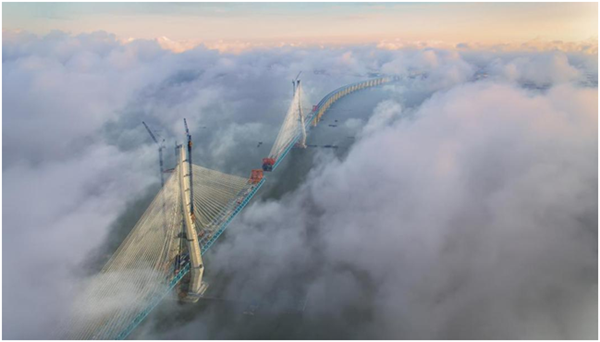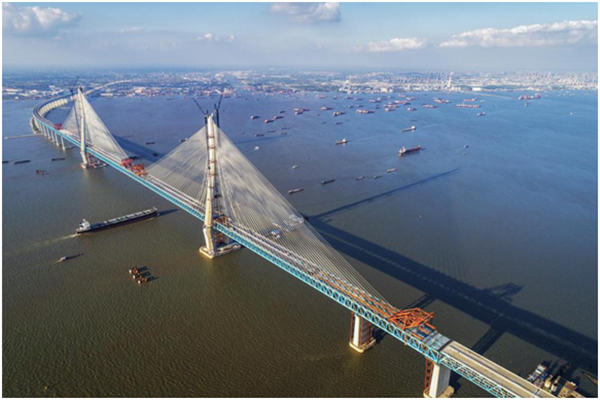The Shanghai-Suzhou-Nantong Yangtze River Bridge, with a main span of 1,092 meters, opened to traffic on July 1. It is the world's first highway-railway dual-use cable-stayed bridge with a span of more than 1,000 meters.
Designed and constructed by China Railway Group Limited (CREC), the bridge starts from Zhangjiagang in Suzhou of East China's Jiangsu province and ends at Tongzhou district in Nantong of East China's Jiangxi province.
Located near the estuary of the Yangtze River and with more than ten ports and harbors nearby, the bridge was built over a section of the river about 6 kilometers' wide on which more than 30,000 ships routinely navigate.
The busy shipping pattern requires the main span of the bridge to be built as long as 1,000 meters.
Before the bridge opened to traffic, the longest-span bridge of its kind in the world was only 630 meters.
The dual-use bridge is also a part of the Nantong-Suzhou-Jiaxing-Ningbo intercity railway and Wuxi-Nantong highway in Jiangsu.
The upper layer of the bridge is a six-lane two-way highway. Vehicles can travel as fast as 100 kilometers per hour across the bridge.
The bottom layer is a two-way four-lane railway with a designed speed of 200 kilometers per hour for the Shanghai-Nantong railway and 250 kilometers per hour for the Nantong-Suzhou-Jiaxing-Ningbo railway.
According to Luo Bing, deputy general-manager of China Railway Major Bridge Engineering Group Co., Ltd., who is also responsible for the Shanghai-Nantong Bridge, the main tower of the bridge is 330 meters high, more than equaling the height of a 110-storey building.
The bridge took 480,000 tons of steel, as much as needed for 12 of China's "Bird's Nest" National Stadiums, and 2.3 million cubic meters of concrete, enough to construct eight National Centre for the Performing Arts.
World's largest steel open caisson
To guarantee a stable bridge with such a long span, large and heavy main pier open caissons are a must.
The open caisson foundation of the bridge is 86.9 meters long, 58.7 meters wide and about 110 meters high. The flat area of the foundation is as large as 12 basketball courts and its height equals that of a 37-storey building.
It is currently the largest underwater open caisson foundation in the world.
With a floater structure and plenum system developed by China Railway Major Bridge Engineering Group Co., Ltd., the 16,000-ton steel open caisson was manufactured and transported as a whole.
World's highest main tower
Luo said that the 330-meter high main tower is currently the highest of its kind in the world.
A new type of concrete with outstanding cracking resistance was developed to solve pumping difficulties. Such concrete can swell by itself in low temperature and show a good anti-cracking effect when used with circulating cooling pipelines and all-closed wind prevention measures.
Moreover, a tower-deviation real-time monitoring technology of the ultra-high concrete main tower was used by China Railway Major Bridge Engineering Group Co., Ltd. during construction to measure deformation of the tower during engineering, which ensures precise verticality.

The Shanghai-Suzhou-Nantong Yangtze River Bridge in construction [Photo/sasac.gov.cn]
World's longest span
The strong steel girder and cable are keys to the long-span structure and heavy load capacity of the bridge.
In addition to the high stiffness, the bridge also needs to be "soft" to bear extreme pressure by micro-deformation and return to normal after the heavy loads pass.
To meet the demands, 500 MPa high-strength steel and 2,000 MPa stay cable were specially developed. Both of them are the strongest in the world.
The 500 MPa of strength means that the maximum weight each square meter of the girder can hold is 50,000 tons, equaling the total weight of 25,000 cars.
The bridge was pulled together by 432 7-millimeter diameter stay cables and each of them has a maximum tensile force of 1,000 tons.
As the heaviest hoisting weight of the bridge is 1,744 tons, the company used a 1,800-ton walking-frame girder crane to guarantee a steady hoisting.

Two sections of the Shanghai-Suzhou-Nantong Yangtze River Bridge are to be connected. [Photo/sasac.gov.cn]
Smart bridge promotes economic growth
It's worth mentioning that the highway layer of the bridge will be covered with Huawei Technologies Co., Ltd.'s 5G micro-base stations and the railway layer will be equipped with ZTT Group's 5G leaky cable.
The 5G infrastructures will make 5G-based application including high-speed internet, high-definition voice messaging and VR/AR possible. Meanwhile, industrial internet of things features like an updating SA network, low delay and strong connection can also be realized on the bridge.
The bridge is the first railway to connect Zhangjiagang to a railway network, so by ship is no longer the only way to travel between Zhangjiagang and Nantong.
What's more, as a main section of the high-speed railway along the Yangtze River of China's "eight vertical and eight horizontal high-speed railway network", its service will promote integrated development of the Yangtze River Delta and travel time between Shanghai and Nantong will be shortened to one hour.
The eight vertical high-speed railways are the railway along the sea and the Beijing-Shanghai, Beijing-Hong Kong-Taiwan, Beijing-Harbin, Beijing-Hong Kong-Macao, Hohhot-Nanning, Beijing-Kunming, Baotou-Haikou and Lanzhou-Guangzhou high-speed railways. The eight horizontal ones are Suifenhe-Manzhouli, Beijing-Lanzhou, Qingdao-Yinchuan, Lianyungang-Alataw Pass, Shanghai-Kunming, Xiamen-Chongqing and Guangzhou-Kunming high-speed railways and the railway along the Yangtze River.

The Shanghai-Suzhou-Nantong Yangtze River Bridge opens to traffic on July 1. [Photo/sasac.gov.cn]
(Executive editor: Wang Ruoting)